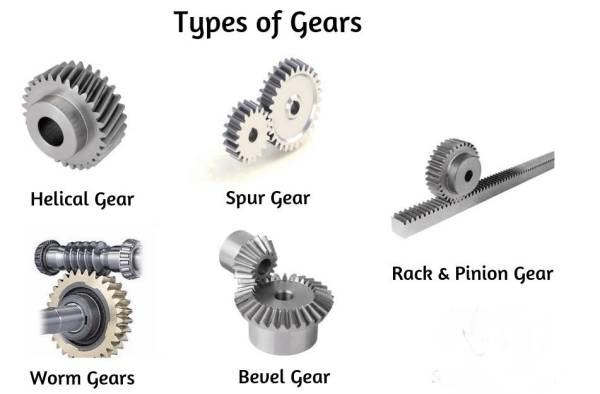Gears are rotating mechanical parts with cut teeth or cogs that transmit power from one rotating shaft to another. Gears work by meshing two or more toothed wheels together so that the teeth of one wheel fit into the gaps of the other wheel, creating a smooth and efficient transfer of power, which increases or decreases speed, changes the direction of rotation, or increases or decreases torque.
Gears are made from various materials, including metal, plastic, and wood. Metal gears are the most common, as they are solid and durable. However, plastic gears are becoming increasingly popular as they are used in applications where metal gears would be too heavy or too expensive.
Types of Gears
Gears are classified into five main categories: spur, helical, bevel, worm, and gear racks.Generally, the shaft orientation, efficiency, speed, and torque determine which type should be used for a specific application.
Spur gears are the simplest and most common type of gear. Spur gears consist of a cylinder or disk with evenly-spaced teeth projected radially and aligned parallel to the axis of rotation. They are mainly used due to their low cost, lack of end thrust, and low maintenance.
A helical gear is similar to a spur gear, with the teeth oriented at an angle (helix angle). Helix angles range from a few degrees to 45 degrees, but the tooth bending load capacity decreases at angles greater than 20 degrees. When operating, more than one tooth is in contact, which leads to a more efficient and quieter operation.
A worm gear consists of a cylindrical worm that meshes with the teeth of a larger gear, called a wheel. Worm gears produce thrust loads and are suitable for high-shock load applications. The main disadvantage of a worm gear is its low efficiency, as a lot of power is lost due to friction between the worm and the wheel.
A bevel gear consists of teeth cut on an angular or conical surface and typically has a 20 degrees pressure angle. The teeth of a bevel gear are cut in a spiral pattern and angled so that when two bevel gears are engaged, the teeth of each gear mesh with each other to provide a smooth, even transfer of rotational motion.
A gear rack converts rotating motion into linear motion. The pinion is a small cylindrical gear with teeth that meshes with teeth of the linear gear (rack). The rack and pinion is a simple, reliable system that can be used in various applications.

Lubrication of Gears
Gears are essential components of any machinery that allow power transfer between two or more components. Proper lubrication of gears will help to reduce friction and wear, increase efficiency, reduce noise, and extend the life of the gear system. The amount of lubricant used depends on the size and type of gear and the speed and load. Over-lubrication can cause excessive wear and noise, while under-lubrication can cause premature wear and fatigue. Manufacturer’s instructions regarding what type of lubricant, the amount of lubricant used, and the interval between each lubrication cycle are the best way to proper lubrication.
In addition, it is crucial to ensure that the lubricant is evenly distributed over the surfaces of the gears and can be accomplished using an appropriate lubricant applicator, such as a brush, roller, spray gun, or an automated lubrication system. Moreover, it is essential to ensure that the lubricant is compatible with the materials of the gears, as particular lubricants may cause corrosion or other damage.
Gears are used in various applications, from simple machines such as clocks and bicycles to more complex machines such as automobiles and airplanes. Without gears, machines would be unable to function properly. When choosing the right gear for an application, it is vital to consider the size, material, type, load capacity, speed, and torque requirements.
Feel free to visit HVH Industrial Solutions if you have any questions, need more information, or are interested in purchasing any type of gear.
Also Check: Accepted Blogs For Write For Us Culture Category









